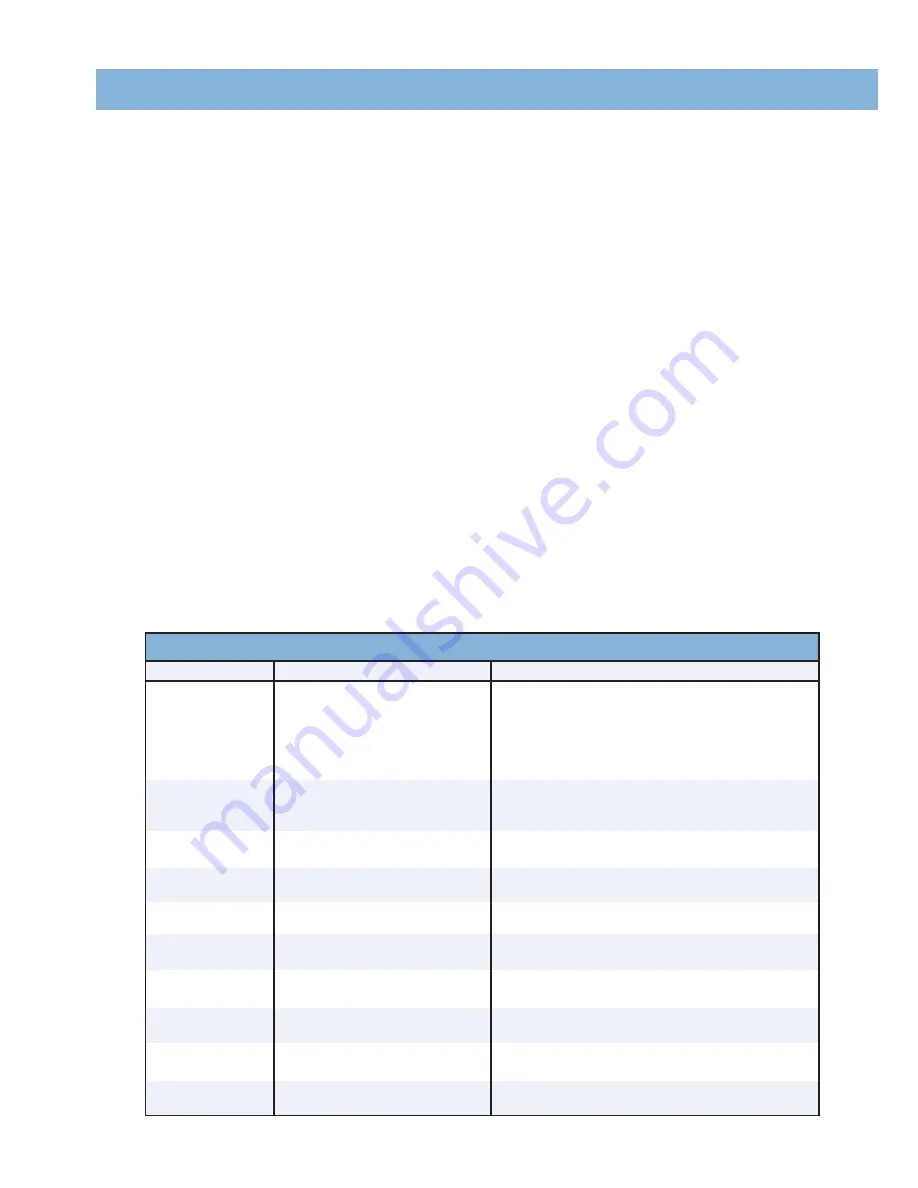
SPA WATER MAINTENANCE TROUBLESHOOTING GUIDE
Cloudy Water
Water Odor
Chlorine Odor
Musty Odor
• Dirty filter
• Excessive oils / organic matter
• Improper sanitization
• Suspended particles / organic matter
• Overused or old water
• Excessive organics in water
• Improper sanitization
• Low pH
• Chloramine level too high
• Low pH
• Bacteria or algae growth
• Buildup of oils and dirt
• High pH
• Low sanitizer level
• Low pH
• Low sanitizer level
• Unsanitary water
• Free chlorine level above 5 ppm
• Total alkalinity and/or pH too low
• High iron or copper in source water
• High calcium content in water – total
alkalinity and pH too high
Organic buildup /
scum ring around spa
Algae Growth
Eye Irritation
Skin Irritation / Rash
Stains
Scale
• Clean filter
• Shock spa with sanitizer
• Add sanitizer
• Adjust pH and/or alkalinity to recommended range
• Run jet pump(s) and clean filter
• Drain and refill the spa
• Shock spa with sanitizer
• Add sanitizer
• Adjust pH to recommended range
• Shock spa with sanitizer
• Adjust pH to recommended range
• Shock spa with sanitizer – if problem is visible or persistent, drain, clean
and refill the spa
• Wipe off scum with clean rag – if severe, drain the spa, use a spa surface
and tile cleaner to remove the scum and refill the spa
• Shock spa with sanitizer and adjust pH
• Shock spa with sanitizer and maintain sanitizer level
• Adjust pH
• Shock spa with sanitizer and maintain sanitizer level
• Shock spa with sanitizer and maintain sanitizer level
• Allow free chlorine level to drop below 5 ppm before spa use
• Adjust total alkalinity and/or pH
• Use a stain and scale inhibitor
• Adjust total alkalinity and pH – if scale requires removal, drain the spa,
scrub off the scale, refill the spa and balance the water
Problem
Probable causes
Solutions
36
preferred because it is totally soluble and nearly pH neutral.
Chlorine (or Bromine) Residual:
The amount of chlorine or bromine remaining after chlorine or bromine demand has been satisfied. The residual is, therefore, the
amount of sanitizer which is chemically available to kill bacteria, viruses and algae.
Corrosion
: The gradual wearing away of metal spa parts, usually caused by chemical action. Generally, corrosion is caused by low pH or by water with levels of TA, CH,
pH or sanitizer which are outside the recommended ranges.
DPD:
The preferred reagent used in test kits to measure the Free Available Chlorine.
Halogen:
Any one of these five elements: fluorine, chlorine, bromine, iodine, and astatine.
MPS:
Monopersulfate is a non-chlorine oxidizer.
Oxidizer:
The use of an oxidizing chemical is to prevent the buildup of contaminants, maximize sanitizer efficiency, minimize combined chlorine and improve water clarity.
Ozone:
Ozone is a powerful oxidizing agent which is produced in nature and artificially by man. Ozone forms no byproducts of chloramines (ozone actually oxidizes
chloramines) and will not alter the water’s pH.
Pathogen:
A microorganism such as bacterium that cause disease.
pH:
The measure of the spa water’s acidity and alkalinity. The recommended pH for the spa water is 7.4 to 7.6. Below 7.0 (considered neutral), the spa water is too
acidic and can damage the heating system. Above 7.8, the water is too alkaline and can result in cloudy water, and scale formation on the shell and heater.
ppm:
The abbreviation of “parts per million”, the standard measurement of chemical concentration in water. Identical to mg/l (milligrams per liter).
Reagent:
A chemical material in liquid, powder, or tablet form for use in chemical testing.
Sanitizer:
Sanitizers are added and maintained at recommended residuals to protect bathers against pathogenic organisms which can cause disease and infection in
spa water.
Scale:
Rough calcium-bearing deposits that can coat spa surfaces, heaters, plumbing lines and clog filters. Generally, scaling is caused by mineral content combined
with high pH. Additionally, scale forms more readily at higher water temperatures.
Shock Treatment:
Also known as “super-chlorination” when chlorine is used. Shock treatment is a process of adding significant doses of a quick dissolving sanitizer
(sodium dichlor is recommended) to oxidize non-filterable organic waste and to remove chloramines and bromamines.
Total Alkalinity:
The amount of bicarbonates, carbonates, and hydroxides present in spa water. Proper total alkalinity is important for pH control. If the TA is too high,
the pH is difficult to adjust. If the TA is too low, the pH will be difficult to hold at the proper level. The desired range of TA in spa water is 125 to 150 ppm.
WATER QUALITY AND MAINTENANCE
Содержание Geneva
Страница 1: ...GenevaTM Niagara Tahitian Elation AspireTM Utopia Aquatic Melodies Series Owner s Manual...
Страница 42: ...39 NOTES...
Страница 43: ......





























